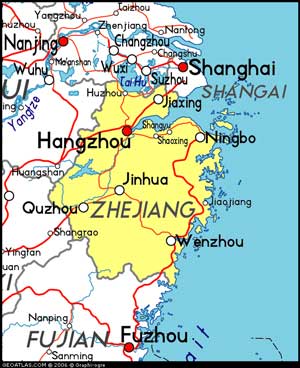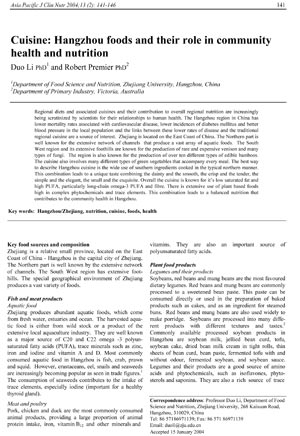|
|
Hangzhou foods and their role in community health and nutrition Regional diets and associated cuisines and their contribution to overall regional nutrition are increasingly being scrutinized by scientists for their relationships to human health. The Hangzhou region in China has lower mortality rates associated with cardiovascular disease, lower incidences of diabetes mellitus and better blood pressure in the local population and the links between these lower rates of disease and the traditional regional cuisine are a source of interest. The South West region and its extensive foothills are known for the production of rare and expensive venison and many types of fungi. The region is also known for the production of over ten different types of edible bamboos. The cuisine also involves many different types of green vegetables that accompany every meal. The best way to describe Hangzhou cuisine is the wide use of southern ingredients cooked in the typical northern manner. This combination leads to a unique taste combining the dainty and the smooth, the crisp and the tender, the simple and the elegant, the small and the exquisite. Overall the cuisine is known for it’s low saturated fat and high PUFA, particularly long-chain omega-3 PUFA and fibre. There is extensive use of plant based foods high in complex phytochemicals and trace elements. This combination leads to a balanced nutrition that contributes to the community health in Hangzhou.
Green leafy vegetables are essential for Zhejiang/Hangzhou cuisine and they accompany almost every meal. Green leafy vegetables in Hangzhou are bok choy, spinach, Chinese broccoli, three-coloured amaranth, tuber onion, Chinese cabbage, caraway and lettuce. Flowering vegetables include citron daylily, cauliflower and broccoli; leguminous vegetables are green bean, snake bean, snow pea, pea and horsebean. Fruiting vegetables that are commonly consumed include cucumber, tomato, capsicum, towel gourd, pumpkin, winter melon, bitter melon, chili, chili pepper, zucchini, corn and eggplant; Rhizomatic and bulb vegetables are onion, spring onion, leek, lotus root, turnip, radish, carrots, potato, sweet potato, taro, yam, water caltrop, celery, garlic bulb and asparagus. The vegetables are good sources for vitamins, minerals, dietary fibre, as well as omega 3 polyunsaturated fatty acid (leafy vegetables). The cusine is rich in cruciferous vegetables that include the Brassica family. This group of vegetables is known to contain the phytochemicals glucosinilates. Many of the glucosinilates, such as sinigrin and sulphoraphane, are known to inhibit or prevent cancer formation in humans. Other horticultural foods commonly consumed in the local cuisine are known to contain phytochemicals important for health and well being in humans. The region is also known for the production of over ten different types of edible bamboos that are an excellent source of dietary fibre. Cured potherb mustard, bok choy, kohlrabi and turnip are also commonly consumed in Hangzhou both at home and in restaurants. |
||||
|
 Zhejiang is located on the East Coast of China. The Northern part is well known for the extensive network of channels that produce a vast array of aquatic foods.
Zhejiang is located on the East Coast of China. The Northern part is well known for the extensive network of channels that produce a vast array of aquatic foods. 
